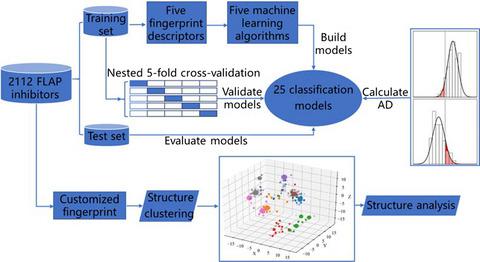当前位置:
X-MOL 学术
›
Chem. Bio. Drug Des.
›
论文详情
Our official English website, www.x-mol.net, welcomes your
feedback! (Note: you will need to create a separate account there.)
Fingerprint‐based computational models of 5‐lipo‐oxygenase activating protein inhibitors: Activity prediction and structure clustering
Chemical Biology & Drug Design ( IF 3.2 ) Pub Date : 2020-10-15 , DOI: 10.1111/cbdd.13657 Guiping Tu 1 , Zijian Qin 1 , Donghui Huo 1 , Shengde Zhang 1 , Aixia Yan 1
Chemical Biology & Drug Design ( IF 3.2 ) Pub Date : 2020-10-15 , DOI: 10.1111/cbdd.13657 Guiping Tu 1 , Zijian Qin 1 , Donghui Huo 1 , Shengde Zhang 1 , Aixia Yan 1
Affiliation

|
Inflammatory diseases can be treated by inhibiting 5‐lipo‐oxygenase activating protein (FLAP). In this study, a data set containing 2,112 FLAP inhibitors was collected. A total of 25 classification models were built by five machine learning algorithms with five different types of fingerprints. The best model, which was built by support vector machine algorithm with ECFP_4 fingerprint had an accuracy and a Matthews correlation coefficient of 0.862 and 0.722 on the test set, respectively. The predicted results were further evaluated by the application domain dSTD‐PRO (a distance between one compound to models). Each compound had a dSTD‐PRO value, which was calculated by the predicted probabilities obtained from all 25 models. The application domain results suggested that the reliability of predicted results depended mainly on the compounds themselves rather than algorithms or fingerprints. A group of customized 10‐bit fingerprint was manually defined for clustering the molecular structures of 2,112 FLAP inhibitors into eight subsets by K‐Means. According to the clustering results, most of inhibitors in two subsets (subsets 2 and 4) were highly active inhibitors. We found that aryl oxadiazole/oxazole alkanes, biaryl amino‐heteroarenes, two aromatic rings (often N‐containing) linked by a cyclobutene group, and 1,2,4‐triazole group were typical fragments in highly active inhibitors.
中文翻译:

5-脂氧合酶激活蛋白抑制剂基于指纹的计算模型:活性预测和结构聚类
炎性疾病可以通过抑制5-脂氧合酶激活蛋白(FLAP)来治疗。在这项研究中,收集了包含2,112种FLAP抑制剂的数据集。通过五种具有五种不同类型指纹的机器学习算法构建了总共25个分类模型。由支持向量机算法构建的具有ECFP_4指纹的最佳模型在测试集上的准确度和Matthews相关系数分别为0.862和0.722。通过应用域d STD-PRO(一种化合物与模型之间的距离)进一步评估了预测结果。每个化合物具有d STD-PRO值,由从所有25个模型获得的预测概率计算得出。应用领域的结果表明,预测结果的可靠性主要取决于化合物本身,而不是算法或指纹。手动定义了一组定制的10位指纹,以通过K-Means将2112种FLAP抑制剂的分子结构聚类为8个子集。根据聚类结果,两个子集(子集2和4)中的大多数抑制剂是高活性抑制剂。我们发现芳基恶二唑/恶唑烷烃,联芳基氨基-杂芳烃,通过环丁烯基连接的两个芳环(通常含N)和1,2,4-三唑基是高活性抑制剂中的典型片段。
更新日期:2020-10-16
中文翻译:

5-脂氧合酶激活蛋白抑制剂基于指纹的计算模型:活性预测和结构聚类
炎性疾病可以通过抑制5-脂氧合酶激活蛋白(FLAP)来治疗。在这项研究中,收集了包含2,112种FLAP抑制剂的数据集。通过五种具有五种不同类型指纹的机器学习算法构建了总共25个分类模型。由支持向量机算法构建的具有ECFP_4指纹的最佳模型在测试集上的准确度和Matthews相关系数分别为0.862和0.722。通过应用域d STD-PRO(一种化合物与模型之间的距离)进一步评估了预测结果。每个化合物具有d STD-PRO值,由从所有25个模型获得的预测概率计算得出。应用领域的结果表明,预测结果的可靠性主要取决于化合物本身,而不是算法或指纹。手动定义了一组定制的10位指纹,以通过K-Means将2112种FLAP抑制剂的分子结构聚类为8个子集。根据聚类结果,两个子集(子集2和4)中的大多数抑制剂是高活性抑制剂。我们发现芳基恶二唑/恶唑烷烃,联芳基氨基-杂芳烃,通过环丁烯基连接的两个芳环(通常含N)和1,2,4-三唑基是高活性抑制剂中的典型片段。











































 京公网安备 11010802027423号
京公网安备 11010802027423号